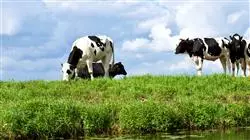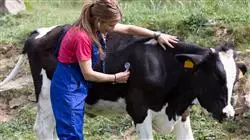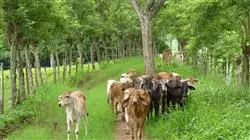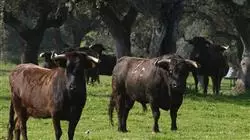University certificate
The world's largest faculty of veterinary medicine”
Description
We offer you the most comprehensive program on the market to bring Extensive Livestock Management to the same level as clinical and sanitary practice, offering your clients the highest quality in both services"

The Postgraduate certificate in Beef and Lidia Cattle in Extensive Farming Systems has a comprehensive program that covers the widest spectrum of species and breeds used in Animal Production in Extensive Systems. Not only is in-depth and specialized attention paid to the most common productions, but also to other much less common but highly relevant productions, which demand a greater degree of specialization from professionals in the area.
Likewise, the degree of knowledge and professional experience of the professors of the Postgraduate Certificate allow them to deal with very specific productions, where it is very difficult to access levels of specialization, except for the small number of people who have had the opportunity to develop their knowledge within the scope of this type of livestock farming.
This program is the most specialized since the development of each subject is structured according to the knowledge and experience of the teaching team, avoiding generalist voluntarism which, although it can provide acceptable global visions, lacks the capacity to study in depth each and every one of the subjects that need to be addressed with the highest quality.
The high levels of knowledge provided by the faculty in the areas of Economics, as well as Genetics and Animal Breeding contribute decisively to consolidate and broaden knowledge in two subjects that are absolutely fundamental for the development of the company.
Immerse yourself in this high-quality education, which will enable you to face the future challenges of Beef and Lidia Cattle in Extensive Farming Systems"
This Postgraduate certificate in Beef and Lidia Cattle in Extensive Farming Systems contains the most complete and up-to-date scientific program on the market. The most important features include:
- The development of case studies presented by experts in the management of veterinary centers
- The graphic, schematic, and practical contents with which they are created, provide scientific and practical information on the disciplines that are essential for professional practice
- New developments in Beef and Lidia Cattle in Extensive Farming Systemss
- Practical exercises where self-assessment can be used to improve learning
- Special emphasis on innovative methodologies in Beef and Lidia Cattle in Extensive Farming Systems
- Theoretical lessons, questions to the expert, debate forums on controversial topics, and individual reflection assignments
- Content that is accessible from any fixed or portable device with an Internet connection
This Postgraduate certificate is the best investment you can make in selecting a refresher program to update your knowledge in Beef and Lidia Cattle in Extensive Farming Systems"
It includes, in its teaching staff, professionals belonging to the field of extensive livestock farming, who bring their work experience to this program, in addition to recognized specialists from prestigious reference societies and universities.
The multimedia content, developed with the latest educational technology, will provide the professional with situated and contextual learning, i.e., a simulated environment that will provide immersive education programmed to learn in real situations.
This program is designed around Problem-Based Learning, whereby the specialist must try to solve the different professional practice situations that arise throughout the program. To do so, the professional will be assisted by an innovative interactive video system created by recognized experts in Extensive Livestock Management.
This program comes with the best educational material, providing you with a contextual approach that will facilitate your learning"

This 100% online Postgraduate certificate will allow you to balance your studies with your professional work while increasing your knowledge in this field"
Syllabus
The structure of the contents has been designed by the best professionals in theBeef and Lidia Cattle in Extensive Farming Systems sector, with extensive experience and recognized prestige in the profession, backed by the volume of cases reviewed and studied, and with a broad command of new technologies.

We have the most complete and up-to-date educational program on the market. We strive for excellence and for you to achieve it too"
Module 1. Fighting Bull Production
1.1. Prototypes and Breed Base of Fighting Cattle I
1.1.1. Origins of the Fighting Bull
1.1.2. The Bravery of the Bull and its Manifestations
1.1.3. Coats and Horns of the Fighting Cattle
1.1.4. Foundational Castes
1.1.5. Breeds derived from the Vistahermosa Breed I
1.2. Prototypes and Breed Base of Fighting Cattle II
1.2.1. Breeds derived from the Vistahermosa Breed II
1.2.2. Crossbreeding with the Vistahermosa Breed
1.2.3. The Lidia Breed in Portugal
1.2.4. The Fighting Breed in France
1.2.5. The Lidia Breed in Mexico
1.2.6. The Lidia Breed in Colombia
1.2.7. The Lidia Breed in Ecuador
1.2.8. The Lidia Breed in Venezuela
1.2.9. The Peruvian Lidia Breed
1.3. Herd Book of the Lidia Cattle Breed
1.3.1. Historical Precedents
1.3.2. The 1990 Regulations
1.3.3. The 2013 Regulations
1.4. Selection in the Fighting Breed
1.4.1. General Aspects of Selection in the Lidia Breed
1.4.2. Morphological Selection
1.4.3. Genealogical Selection
1.4.4. Functional and Behavioral Selection: The Temptation and its Results
1.4.5. Other Selection Methods
1.4.6. Selection Pressure
1.4.7. Proof of Offspring
1.4.8. Pardon as a Method of Selection
1.4.9. The Breeding Program for the Lidia Breed
1.5. Breeding and Production Cycles of the Fighting Cattle
1.5.1. Coverage
1.5.2. Birth and Lactation
1.5.3. The Unborn and Weaning
1.5.4. The Horseshoe Mill
1.5.5. Rearing
1.5.6. The Selection of Breeders
1.5.7. Handling, Stowage and Shipments
1.5.8. Recognition in the Bullring
1.6. The Feeding of Fighting Cattle
1.6.1. General Dietary Guidelines
1.6.2. The Feeding of Breeding Cows
1.6.3. Stallion Feeding
1.6.4. Heifer Feeding
1.6.5. Yearling Feeding
1.6.6. Feeding of Calves (Young Bulls)
1.6.7. Feeding of Foals
1.6.8. Feeding of Bulls
1.7. Most Frequent Pathologies in Lidia Cattle
1.7.1. Infectious Pathologies
1.7.2. Parasitic Pathologies
1.7.3. Nutrition-Related Pathologies
1.7.4. Pathologies Related to the Breeding and Management of Fighting Cattle
1.7.5. Injuries Produced During Bullfighting and their Treatment in Pardoned Bulls
1.8. Management and Facilities for Fighting Cattle Breeding
1.8.1. Handling Facilities in Lidia Cattle Farming
1.8.2. Management of Breeding Cows
1.8.3. Stallion Management
1.8.4. Management of Rebreeding Heifers
1.8.5. Management of Males from Yearlings to Bulls
1.8.6. Halters, Dogs and Other Elements Used in the Handling of Fighting Bulls
1.9. Assisted Reproduction in Fighting Livestock
1.9.1. Peculiarities of Assisted Reproduction in the Cattle of the Fighting Bulls
1.9.2. Techniques for Semen Collection and Preservation
1.9.3. Artificial Insemination
1.9.4. Techniques for Oocyte Retrieval and Preservation
1.9.5. Embryo Procurement, Conservation and Transfer Techniques
1.9.6. The Market for Genetics in the Cattle Breeding Industry
1.10. Economics of the Cattle Breeding Farm
1.10.1. The Current Bullfighting Bull Market
1.10.2. Income and Expenses of Lidia Cattle Farming
1.10.3. Production Costs
1.10.4. Income from Sales and Subsidies
1.10.5. Rural Tourism as a Complementary Income
1.10.6. The Profitability of the Farms in the Bullfighting Industry
1.10.7. Current Situation and Economic Prospects of the Lidia Cattle Breeding Industry
Module 2. Extensive Beef Cattle Production
2.1. Racial Basis of Extensive Beef Cattle Production I
2.1.1. Beef Cattle Morphology
2.1.2. Production and Adaptation to the Environment
2.1.3. Indigenous Breeds Specialized in Meat Production
2.1.4. Endangered Native Breeds Specialized in Meat Production
2.2. Racial Basis of Extensive Beef Cattle Production II
2.2.1. Mixed Breeds Specialized in Meat Production
2.2.2. Main European, American and Asian Breeds Specialized in Meat Production
2.2.3. Cebuinos and Hybrids
2.2.4. Buffalo
2.2.5. Bisontes
2.3. Yield Control and Data Collection Systems
2.3.1. Individual Morphological, Productive and Reproductive Data (Study Variables)
2.3.2. External and Internal Influencing Factors
2.3.3. Methodologies for Data Collection and Analysis
2.4. Extensive Beef Cattle Production Systems and Handling Facilities
2.4.1. Grazing in Beef Cattle
2.4.2. The Pasture
2.4.3. Grazing in Mountain Areas
2.4.4. Grazing in Other Rainfed Areas
2.4.5. Grazing on Irrigated Farms and in Marsh Areas
2.4.6. Dietary Supplementation in Extensive Beef Cattle Production Systems
2.4.7. Rearing and Handling Facilities for Beef Cattle Farmed in Extensive Systems
2.5. Beef Cattle Feeding in Extensive Farming
2.5.1. General Feeding Guidelines for Cattle in Extensive Production
2.5.2. Cow Feeding in Different Ecosystems
2.5.3. Stallion Feeding
2.5.4. Feeding of Replacement Heifers
2.5.5. Feeding of Beef Calves in Extensive Systems
2.6. Most Frequent Pathologies in Beef Cattle Farmed in Extensive Systems
2.6.1. Pathologies of Infectious Origin
2.6.2. Pathologies of Parasitic Origin
2.6.3. Pathologies of Metabolic Origin
2.6.4. Reproductive Pathologies
2.6.5. Pathologies Related to Handling
2.7. Reproductive Management of Beef Cattle Farms
2.7.1. Reproductive Systems Used in Extensively Farmed Beef Cattle
2.7.2. Reproductive Management of Cows
2.7.3. Reproductive Management of Stallions
2.7.4. Reproductive Management of Heifers
2.8. Organoleptic Characteristics and Meat Quality in Beef Produced in Extensive Systems. Beef Production for PGI and PDO. Organic Production
2.8.1. Organoleptic Characteristics and Meat Quality of Beef from Cattle Produced in Extensive Systems
2.8.2. Protected Geographical Indications in Beef Cattle
2.8.3. Beef Cattle Protected Denominations of Origin
2.8.4. Organic Beef Cattle Production
2.9. Production of Beef and Other Red Meat in Extensive Systems. Wagyu Beef Production. Lidia Meat. Buffalo Meat. Bison Meat
2.9.1. Beef Production in Extensive Beef Systems
2.9.2. Beef Production in Extensive Systems
2.9.3. Wagyu and Kobe Beef Production
2.9.4. Lidia Beef
2.9.5. Buffalo Meat
2.9.6. Bison Meat
2.10. Economic Aspects of Beef Cattle Production in Extensive Systems
2.10.1. Income and Expenses of Extensive Beef Cattle Farms
2.10.2. Main Factors Affecting Farm Profitability
2.10.3. The Extensive Beef Cattle Market
2.10.4. Current Situation and Future Prospects

This program will allow you to seamlessly advance in your career"
Postgraduate Certificate in Beef and Lidia Cattle in Extensive Farming Systems
This Postgraduate Certificate goes in depth into all aspects of knowledge of the fighting bull, serving as a starting point in their professional activity within the world of the bull for those who wish to access it and at the same time increase the level of specialization and knowledge of those who are already incorporated into this activity. Likewise, the main varieties of production derived from beef cattle in extensive systems are presented, and their characteristics and economic situation in the market are analyzed. The Postgraduate Certificate in Beef and Lidia Cattle in Extensive Farming Systems of TECH Global University is a high-quality program that aims to prepare students for the management and exploitation of these species in extensive systems. This Postgraduate Certificate focuses on two important sectors of agriculture and livestock, meat production and the bullfighting sector. Livestock farming is an important activity in the rural world, as it helps to promote the economic and social development of rural areas. In this sense, the Postgraduate Certificate seeks to provide knowledge to students so that they can develop skills that will allow them to work in beef and fighting bull production projects in extensive systems. The Postgraduate Certificate students will be able to acquire skills and knowledge in the planning and management of beef and fighting bull farms in extensive systems. In addition, they will learn about feeding, breeding, reproduction and health techniques of these species and how to adapt to new technologies and innovations in this sector.
Don't miss the opportunity to get qualified and advance professionally
The set of techniques that will be developed throughout the Postgraduate Certificate will allow the student the optimal management of livestock, ensuring at all times the animal welfare and proper maintenance of the farm. Study from the comfort of your home or anywhere in the world with just an Internet connection.







